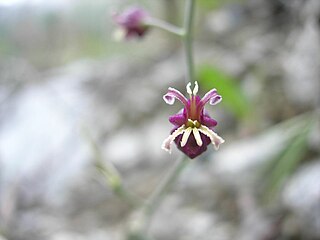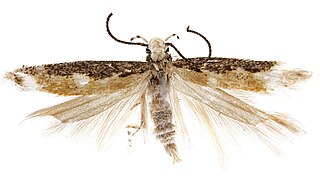Related Research Articles

The Gelechiidae are a family of moths commonly referred to as twirler moths or gelechiid moths. They are the namesake family of the huge and little-studied superfamily Gelechioidea, and the family's taxonomy has been subject to considerable dispute. These are generally very small moths with narrow, fringed wings. The larvae of most species feed internally on various parts of their host plants, sometimes causing galls. Douglas-fir (Pseudotsuga) is a host plant common to many species of the family, particularly of the genus Chionodes, which as a result is more diverse in North America than usual for Gelechioidea.

Parosphromenus is a genus of gouramies native to freshwater in Southeast Asia. All species are highly specialized peat swamp inhabitants native to southeast Asia, and the males are usually brightly colored in breeding dress; however, their need for soft, acidic water and live food prohibits the genus from becoming popular aquarium fish.
Passiflora sanctae-barbarae is a species of plant in the family Passifloraceae. It is endemic to Ecuador.
Sphaeradenia sanctae-barbarae is a species of plant in the Cyclanthaceae family. It is endemic to Ecuador. Its natural habitat is subtropical or tropical moist montane forests.

Caryocolum is a genus of moths in the family Gelechiidae.

Chrysoesthia is a genus of moths in the family Gelechiidae.

Deltophora is a genus of moths in the family Gelechiidae. The genus was originally described from South Africa and based on a taxonomic revision contains about 20 species on all continents except Antarctica. Host plants of larvae and adults are only known for two Chinese species of Deltophora. These two species feed on two species of Phyllanthus (Phyllanthaceae), which are their exclusive hosts for both the larval stage and as a nectar-source for the adults. Molecular data support the placement of Deltophora in the Gelechiidae.

Gnorimoschema is a genus of moths in the family Gelechiidae.

Megacraspedus is a genus of moths in the family Gelechiidae, found primarily in the Palearctic.

Mesophleps is a genus of moths in the family Gelechiidae. The genus was erected by Jacob Hübner in 1825.
Monochroa is a genus of moths in the family Gelechiidae.

Neopalpa is a genus of moths in the family Gelechiidae. They are found in California, Arizona, and northern Mexico. Neopalpa is classified in the tribe Gnorimoschemini and is most closely related to the genera Ochrodia and Ephysteris.
Nevadopalpa is a genus of moth in the family Gelechiidae.

Caulanthus amplexicaulis is a species of flowering plant in the family Brassicaceae known by the common name claspingleaf wild cabbage.

Brachycythara is a genus of very small predatory sea snails, marine gastropod mollusks in the family Mangeliidae.

Dichomeridinae is a subfamily of moths in the family Gelechiidae.

Thalassotrechus barbarae is a species of beetle in the family Carabidae, the only species in the genus Thalassotrechus.

Neopalpa neonata is a species of moth in the family Gelechiidae. It is found in southwest of North America, where it has been recorded throughout most of California, Arizona and the most western regions of Northern Mexico.
Marmyan is an extinct genus of scale insect, containing a single species, Marmyan barbarae and unplaced in any coccid family. The genus is solely known from the Albian – Cenomanian Burmese amber deposits.

Neopalpa donaldtrumpi is a moth species of the genus Neopalpa occurring in Southern California and Northern Mexico. It was described in 2017 by Iranian-Canadian scientist Vazrick Nazari. Known for its yellowish-white head scales being reminiscent of Donald Trump's hair, the moth was given its name because Nazari stated that he wanted "to bring wider public attention to the need to continue protecting fragile habitats in the US that still contain many undescribed species."
References
| This article on a moth of the tribe Gnorimoschemini is a stub. You can help Wikipedia by expanding it. |